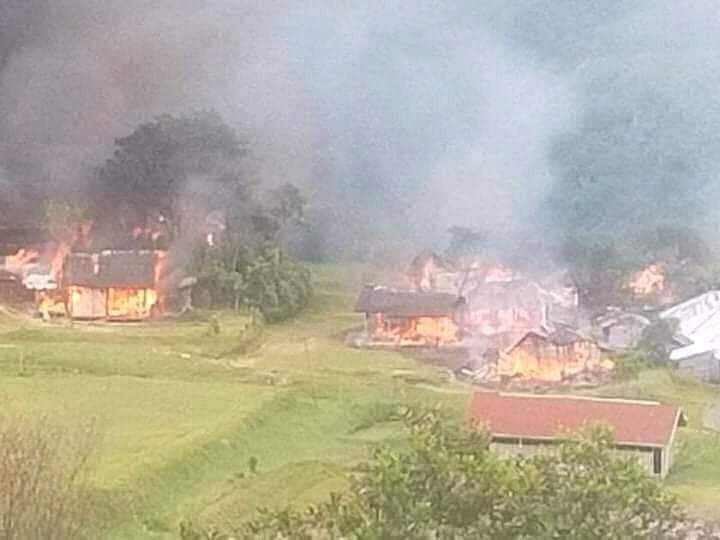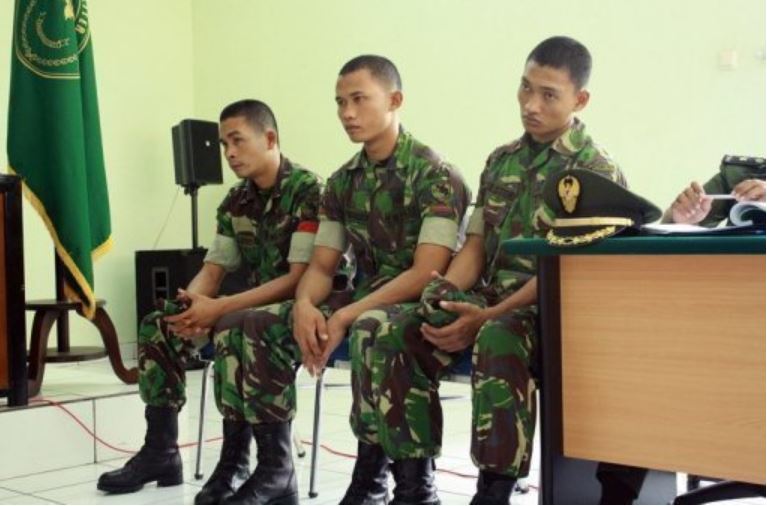On 21 October 2022, around 40 indigenous peoples of Pantai Raja Village, Kampar Regency, Riau, went to Jakarta with the blessing of the Malay Customary Institution of Riau Province (LAM Riau) to fight for their land, which has been controlled by the state-owned enterprise PTP Nusantara V (PTPN V) since 1984. PTPN V seized 1013 hectares of indigenous people’s land.
Many representatives of the Pantai Raja indigenous community of Kampar Regency, together with elements of civil organisations, held an action called “Picking up justice in Jakarta” at the Ministry of State Owned Enterprises (SOE) (Kementerian Badan Usaha Milik Negara -BUMN-) in Jalan Medan Merdeka Selatan, Central Jakarta. They called on SOE Minister Erick Thohir to return their land, allegedly seized by PTPN V decades ago. “Where is the action of SOE? PT Perkebunan Nusantara V’s land belonging to the indigenous people of Pantai Raja was seized and then used as a state asset,” read the banner of the residents unfurled in front of the BUMN Ministry building.
History of Land grabbing
The history of this case dates back to 1984. The location of the land with an area of around 1,013 hectares, before the expansion of PTP Nusantara V into the space formerly called Sei Geringging, Sei Iduik and Sialang Kubang in Pantai Raja Village, Siak Hulu District, Kampar Regency. At that time, of course, PTP Nusantara V was not yet established. PTPN V, now a subsidiary of the plantation holding company PTP Nusantara III, was only established in 1996 through the fusion of several plantations limited liability companies (PTP), namely PTP II, PTP IV and PTP V in Riau Province.
Based on the community’s version of the chronological story, residents carried out various crop cultivation activities before the arrival of PTP V in their area. Among other things, rice, corn, cinnamon, and others. Later, the type of plant changed to rubber, whose traces are still visible today.
“In 1999, PTPN V recognised 150 hectares of community land were included in PTPN V’s core plantation area. The acknowledgement was accompanied by a promise to return the indigenous people’s land. In 2019, Komnas HAM provided recommendations for conflict resolution. The commitment to return the community’s land and recommendations for conflict resolution was ignored by PTPN V. Instead, the community was criminalised, “explained Gusdianto, Representative of the Indigenous Peoples of Pantai Raja.
The promise of the Ministry of Agrarian Affairs and Spatial Planning/ National Land Agency (ATR/ BPR)
The legal uncertainty of the conflict between indigenous peoples and PTPN V for more than 38 years is due to the reluctance of the state to resolve the dispute. The state’s slow pace of conflict resolution has prompted the community to “Pick Up Justice in Jakarta”. Since arriving in Jakarta on 23 October 2022, the community has submitted complaints to the Minister of Agrarian Affairs and Spatial Planning/National Land Agency (ATR/ BPN), the Presidential Staff Office, the Ministry of SOE (BUMN) and the Executive Board of Nahdlatul Ulama (PBNU). A meeting with the Minister of ATR/ BPN Hadi Tjahjanto was held on 24 October 2022.
“Pantai Raja Village Chief Khaerud Zaman and I conveyed the case of the conflict between the indigenous people of Pantai Raja and PTPN V to the Minister of ATR/BPN. During the meeting, the ATR/BPN Minister said that in resolving the conflict between PTPN V and the community, he needs to sit together with the Ministry of BUMN and the Ministry of Villages. At the end of the meeting, the Minister promised to help resolve the conflict. We are waiting for the realisation of this promise,” said Okto Yugo Setyo, Deputy Coordinator of Jikalahari Riau.
Pantai Raja indigenous people then met with the Agrarian Reform Team of the Presidential Staff Office (KSP). KSP has received community complaints since 2020 and followed up with field visits. The KSP Agrarian Reform Team said that there are 223 conflicts in Indonesia involving state-owned enterprises, including PTPN V. According to KSP, the obstacles in resolving disputes with state-owned enterprises are related to the Regulation of the Minister of SOE (BUMN) Number 2 of 2010 on the Procedures for the Write-off and Transfer of SOE Fixed Assets.
Statements from non-governmental organisations
Boy Even Sembiring, Executive Director of WALHI Riau, stated that the conflict between Pantai Raja Indigenous People and PTPN V is one of many agrarian conflicts in Riau. The choice of PTPN V (a state-owned company) to ignore conflict resolution is an imperfect reflection of a state that prioritises business over the people’s interests. According to him, the Ministry of SOE and the business entities under it should take part in accelerating the President’s agrarian reform program. The Governor of Riau and the Kampar Regent should also pay attention to the conflict by forcing PTPN V to return to the community’s customary land or expel PTPN V from Riau.
Zaenal Arifin, Head of the Advocacy Division of YLBHI, stated that the conflict faced by the Pantai Raja indigenous community is one of the many conflicts that have failed to be resolved in the two periods of the Jokowi regime. Resolving agrarian conflicts requires political commitment from the President because the typology of conflicts involves cross-ministries. He said, “Currently, the Jokowi regime is surrounded by public officials involved in the business vortex that triggers various agrarian conflicts. Conflicts affecting indigenous peoples also occur because of the absence of recognition and protection of indigenous peoples and their territories. It is time for the government to pass the Indigenous Peoples Bill immediately”.
The conflict between the indigenous people of Pantai Raja and PTPN V must be a priority for President Jokowi to resolve. At least for the following reasons:
First, the conflict dragged on for 38 years and caused the community misery. In 1984 PTPN V came to Pantai Raja without any dialogue and immediately destroyed the community’s rubber plantation. One hundred fifty-seven families lost their rubber plantations, their livelihood source.
Secondly, PTPN V in 1999 recognised that Pantai Raja Indigenous Peoples owned a 150-hectare rubber plantation in the core Sei Pagar PTPN V plantation. The acknowledgement and agreement at that time were made in writing and witnessed by the Kampar district government, the head of the Siak Hulu police sector.
Third, the community has been struggling in the region and has been trying, according to the legal corridor, to ask for local government settlements ranging from the Kampar Regent to the Governor of Riau.
Fourth, the community became victims of criminalisation and was sued in court due to the unresolved conflict. When the community demanded a mediation agreement by Komnas HAM RI, PTPN V, through the Director of PTPN V, Jatmiko K Santosa, reported 14 community representatives to Riau Police on charges of unauthorised land occupation. PTPN V sued 14 community representatives in the Bangkinang District Court for 14.5 billion Rupiah.

